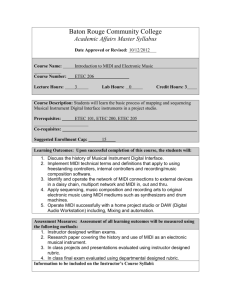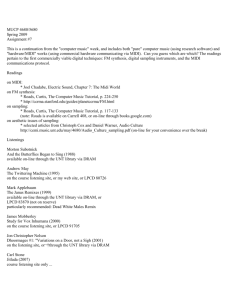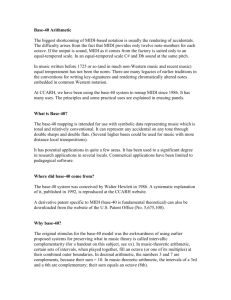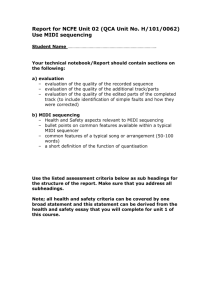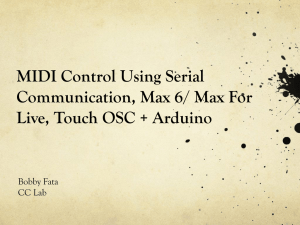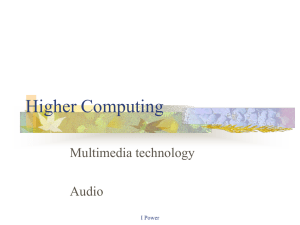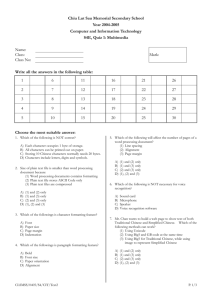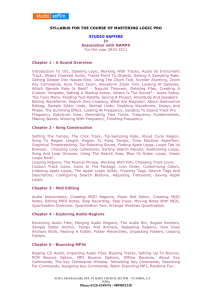Sound / Audio - Department of Computer Engineering
advertisement
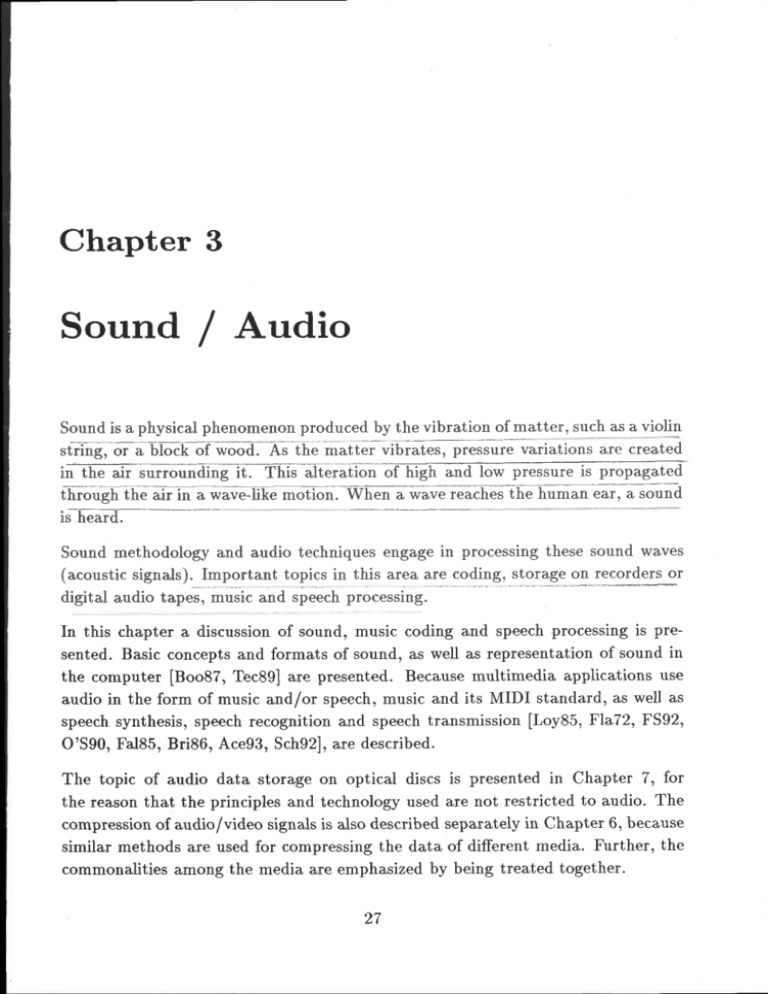
Chapter 3
Sound / Audio
producedby the vibration of matter, suchasa violin
Soundis a physicalphenomenon
siiing or aTIoEk-oT-wood.Fs the m;tter viUrates,preiJure variations are created
in@
tTrougfi'thtaii]n;w;tdf[e
moTion.Wnen a wavertffi
is-hearcl.
Soundmethodologyand audio techniquesengagein processingthesesoundwaves
(acousticsignals).Important topicsin this areaare coding,storageon recordersor
digital audio tapeq-musicand speechpro."rring.
In this chapter a discussion of sound, music coding and speech processing is presented. Basic concepts and formats of sound, as well as representation of sound in
the computer [Boo87, Tec89] are presented. Because multimedia applications use
audio in the form of music and/or speech,music and its MIDI standard, as well as
speechsynthesis, speechrecognition and speechtransmission [Loy85, Fla72, FS92,
O'S90, Fal85, Bri86, Ace93, Sch92],are described.
The topic of audio data storage on optical discs is presented in Chapter 7, for
the reason that the principles and technology used are not restricted to audio. The
compression of audio/video signals is also described separately in Chapter 6, because
similar methods are used for compressingthe data of diferent media. Further, the
commonalities among the media are emphasizedby being treated together.
27
CHAPTER 3. SOUND / AUDIO
3.1
Basic Sound Concepts
Sound is produced by the vibration of matter. During the vibration, pressurevariafionilie created in the air surrounding it. The pattern of the oscillation is called
Figure 3.1: Oscillation of an air pressureuo,I)e.
The wav_eformlep_9atqthe same shape at regular intervals and this portion is called
a period. Since sound wavesoccur natur"lly, ih"y are never perfeiil!-imooth or
petioaic. However, sound.sthat dispiiy a recognizablep"ri.ai.ity t_"ra
_uniformly
to be more musicalthan those that are nonperiodic. Examplesof periodic round
sourcesare musical instruments, vowel sounds,the whistling windand bird son$.
Nonperiodic sound sourcesinclude unpitched percussioninstruments, coughs and
sneezesand rushing water.
Frequency
The frequency of a sound is the reciprocal value of the period; it represents the
number of periods in a secondand is measuredin hertz (Hz) or cyclespr, ,r"o-id,
tcpsl. A convenientabbreviation,kHz (kilohertz),is used to indicate thousands
of oscillations per second: I kHz equals 1000 Hz [Boo87]. The frequency range is
divided into:
29
3.1. BASIC SOUND CONCEPTS
Infra-sound
Human hearing frequency range
Ultrasound
Hypersound
from
from
from
from
0 to 20 Hz
20 Hz to 20 k}Jz
20 kHz to 1 GI{z
1 GHz to 10 THz
the frequency,rangeof
Multimedia systems typicall-y make use of s9u1d--9n]1_r_v-i_!hin
human hearing. We will call sound within the human hearing range oudfo and the
waves in.this frequency range acoustic signals [Boo87]. For example, speech is an
humansjTy:i: signalshave.a,._fretugl.t
acoustic
r:g_"4produced.by
rylq:FlYj"l
20 Hz and 20 kHz. Besides speechand music, we denote any other audio signal as
n7is1.
Amplitude
A sound also has an amplitude, a property subjectively heard as loudness. The
amplitude of a sound is the measure of the displacement of the-iir pressule wave
from its -"ir,, o, qoi"r."nt state.
3.1.1
Computer
Representation
of Sound
The smooth, continuous curve of a sound waveform is not directly represented in
a computer. A computer meadur-eFtheampiitude of the waveiorm at regular-tirne
inteivals to pioduce i seriesbf nomb"m. Each of these measurementsis { sa6pl-e.
Figure 3.2 iliustrates one period of a digitally sampled waveform.
The mechanism that converts an audio signal into digital samples is the Analog-toDigital Conuerter (ADC). The reverseconversionis performed by a Digital-to-Analog
Conuerter (DAC).The AM79C30A Digital SubscriberController chip is an example of an ADC and is available on SPARCstationsrM. Desktop SPARCTMsystems
include a built-in speaker for audio output. DAC is also available as a standard
UNIXTMdevice. For exampie, SPARCserver 6xx systems do not have an interna.l
speaker,but support an external microphone and speaker.
CHAPTER 3. SOUND / AUDrO
00
Q
Figure 3.2: Sampled uaueform.
Sampling Rate
The rate at which a continuous waveform (Figure 3.1) is sampled is called the sampling rate. Like frequencies,sampling rates are measuredin Hz. The CD standard
samplingrate of 44100H; m;uns ihit the waveformis samplecl++tObtimes per second. This seemsto be abovethe frequencyrangeih" hu-.n
hear. However,
"ui.un
the bandwidth (which in this caseis 20000Hz 20 Hz = 19980Hz) that aigituffy
sampled audio signa! cal.lepre-r"n!l
i! _1!most equal to half of the CD standar?
sampling rate (44100Hz). This is an appiication of the Nyquist sampling theorem.
("Foriossiess
digitizaiiq;,ll'-q:"gpli"g,-'lt.!Ig49 !L{tqgl
the maxigum
lwi_ce
frequencyresponses-') Hence,a sampling rate of 44100 Hz can only representfrequenciesup to 22050Hz, a boundary much closerto that of human hearing.
Quantization
Just as a waveform is sampled at discrete times, the value of the sample is also
discrete. The resolution or quantizationof a sample value depends on the roti6Jt
of bits used in measuringthe height of the waveform. An 8-bit qu"ili;i;;liil;
256 possible values; 16-bit 6p-qoaliir quantization rer,,lii i"
;rl*t
OSSSO
"""i
Figure 3.3 presents a 3-bit quantization. The sampled waveform with a 3-bit quan-
3.1. BASIC SOUNDCONCEPTS
31
b!
a)
(]
o
Figure 3.3: Three-bit quantization.
tization results in only eight possible values: .75, .5, .25,0, -.25, -.5, -.75 and -1.
The shape of the waveform becomes less discernible with a lowered quantization,
i"i"ft .igttt
th" r.""altn"
i.e., thelower the quantiiJiion, the lower the quality
"f
be abrzzing sound).
Sound Hardware
Beforesound can be processed,a computer needsinput/output devices.Microphone
jacks and Uiilii-i" speakersare devicesionnected to an ADC and DACf r"ip"iiin"Iv
for the input and output of audio.
3.L.2
Audio Formats
The AM79C30A Di.Sit1l Q"!::lb:l
Controller provides uoice-quality audio. This
converter uses an 8-bit p-law encoded quantization and a sampling rate of 8000
Ez. This representatiorlis conriJ"i"a fatt and accurate enough f"t t:i'[iphon"-oitttty
speechinput.
CD-qualityaudio is generatedif the stereo DAC operatesat 44100samplesper
secondwith a 16-bit linear PCM (Pulse Code Modutation)"in{id,ed qtiiTiz"ti"n
lJBtel.
32
CHAPTER3. SOUND / AUDrO
The above examples of telephone-quality and CD-quality audio indicate that important format parameters for specificationof audio are: sampling rate (e.g.r8072.8
- - simples/second) and sample quaniization (e.g., 8-bit quaniiiaiion).
3.2
Music
The relationship between music and computers has become more and more important, specially considering the development of MIDI (Music Instrument Digital
Interface) and its important contributions in the music industry today. The MIDI
interface between electronic musical instruments and computers is a small pi"." ot
equipment that plugs directly into the computei's serial port and allows tit" tru*mission of music signals. MIDI is consideredto be the most compact interface that
allows full-scale output.
3.2.1
MIDI
Basic Concepts
MIDI is a standard that manufacturers of electronic musical instruments have agreed
opotr. it ir i r"t of specificationsthey use in building their instruments so thii the
instiirments of different manufacturers can, without difficulty, .o--ooi.ut"
information betweenone another [Lov85l.
**i.it
A MID-I ]1t9r{1ce hq9 two differert components:
o Hard,wareconnectsthe equipment. It specifiesthe physical connection between
musical instruments,iiipulates that a MIDI port is built inio an instrument,
-specifiesa MIDI cable (which connects two instiumenirl ""a-a""ir"t:itt ut".tronic signalsthat are s-entover_the cable.
o A da'ta format encodes the information traveling through the hardware. A
MIDI dataformat doesnot include an encoding of individual samplesas the audio format does (Section3.1.2). Instead of individual samples,aninstrument
connecteddata format is used. The encodingincludes,besidesthe instrument
specification,the notion of the beginning and end of a note, basic frequency
MUSIC
and sound volume. MIDI data ailow an encodins of about 10 octaves. which
correspondsto 128 notes.
r!9 MIDI dala f91matis digital;.thedata qrygrolpgg*!!]9l!ID!.!g!!s::.
Each MIDI messagecommunicatesone mus'icaleuentbetweenmachines. These
musical events are usually-actions that a musician performs while playing a
musicalinstrument. The action might be pressingkeys,moving slider controls,
setting switchesand adjustingfoot pedals.
When a musician pressesa piano key, the MIDI interface creates a MIDI
*"rrug" wheie thir bbginning i;f the note wilh lt-s sfrokrj iilt-eii3iiy is ercotdl
"i"
tt'" -o*"t-tr." t"v i.
Trrii message
ii"i;anffittba"i""u"oih"i -u.hit
".
not t"n
released..
a corresponding
is transmitt"a-ffin.
signal(MIDI message)
-ltiDT.i"la,
minutes of music, this processcreatesabout 200 Kbytes ,jf
is eisentiattyt'i.;ss
1tran,*reequivaGntt{y-g
which
in
-m
'l ^,_C_n
dl1i. :_q{"gdFrearn
the same time-.
If a musical instrument satisfies both components of the MIDI standard, the instrument is a MIDI d.euice(e.g., a synthesizer),capable of communicating with
other nrIIDl. devicesthrough channels. ttt" Ulnt standard specifies16 channels.
A MIDI device (musical instrument) is mapped to a channel. Music data, transmitted through a channel, are repr,od-ucedat the rec_eive_ljfq9_yj![=tl9'9y,_1t"llt_@t
instrument. The MIDI standard identifies 128 instrumentlr*r_tgl_14_t_qg
qgilg g{grls
the
Acoustic
(e.g.,telephone,air craft), with unique numbers. For example,0 is for
Grand Piano, 12 fot the marimba, 40 for ihe vioLnf?l"tor tfre fliri;;;il.
Some instruments allow only one note to be played at a time, such as the flute.
Other'instruments'allow more than one note'to be piiyed simultaneo"rty, r".tt u.
the organ. The maximum number ol simultaneously
notes per channelis a
tlw"9
main property of each synthesizer. The range can be from 3 to 16 notes per channel.
To tune a MIDI device to one or more channels, the device must be set to one of
the MIDI reception modes. There are four modes:
Mode 1: Omni On/Poly;
Mode 2: Omni On/Mono;
34
CHAPTER 3. SOUND / AUDIO
Mode 3: Omni Off/Poly;
Mode 4: Omni Off/Mono
The first half of the mode name specifieshow the MIDI device monitors the incoming
MIDI channels. If Omni is turned on, the MIDI device monitors all the MIDI
channels and responds to all channel messages,no matter which channel they are
transmitted on. If Omni is turned off, the IIIDI device respondsonly to chinnel
messages
sent on the channel(s)the deviceis set to receive.
The secondhalf of the mode name tells the MIDI device how to play notes coming
in over the MIDI cable. If the option Poly is set, the device can play seveial notes
at a time. it ttt" mode is set to Mono, the device plays notes like a monophonic
synthesizerti19.
note
_oo:
3,j .1
3.2.2
MIDI
Devices
Through the MIDI interface, a computer can control output of individual instruments. On the other hand, the computer can receive,store or processcoded musical
redata through the same interface. The data are generated with a keyboard
11d
produced through a sound generator. A sequencercan store data. Further, it may
also modify the musical data. In a multimedia system, the sequenceris a computer
application.
The heart of any MIDI system is the MIDI synthesizer device. A typical synthesizer looks like a simple piano keyboard with a panel full of buttons, but it is far
more (more detailed information on synthesizerscan be found in [Boo87].). Most
synthesizershave the following common componenl,s:
o Sound Generators
Sound generators do the actual work of synthesizing sound; the purpose of
the rest of the synthesizer is to control the sound generators. f!9 nrilc].q.1l
purpose of the generator is to produce an audio signal that becomes sound
when fed into a loudspeaker. By varying the voltage oscillation of the audio
3.2. MUSIC
35
signal, a sound generator changesthe quality of the sound - its pitch, loudness
and tone color - to create.a wide variety of sounds and notes.
Internally, sound-generation can be done in different ways. One way is to
store the acoustic signals as MIDI data in advance. Afterwardi; ;ii";i;i;d
\=.{-IDId3ta are transformed with a digital-analog adapter into acoustic signals.
Individual notes are composedin a timely fashion. Another method is to create
acoustic signals synthetically.
Microprocessor
The microprocessor communicates with the keyboard to know what notes
the musician is playing, and with the control pale-|!-o-k1ow what commalds
the musician wants to send to the microprocessor. The microprocessorthen
specifiesnote and sound commands to the sound generators;in other words,
the microprocessorsendsand receivesMIDI messages.
Keyboard
The keyboard affords the musician's direct control of the synthesizer. Pressing keys on the keyboard signals the microprocessor what notes to play and
how long td pl;t ihem. Some synthesizer keyboards can also signal to the
microprocessor how loud to play the notes and whether to add uibrato or
other effectsto the notes. The sound intensity of a tone dependson the speed
and acceleration of the key pressure. The keyboard should have at least five
octaveswith 61 keys.
Control Panel
The control panel controls those functions that are not directly concernedwith
notes and durations (controlled by the keyboard). Panel controls include: a
slider that sets the overall volume of the synthesizer,a button that turns the
synthesizeron and off, and i menu that calls up different patchesfor the sound.
generators to play.
Auriliary Controllers
Auxiliary controllers are available to give more control over the notes played
on the keyboard. Two very common variableson o ry"ili"rizeriri pttit Urrn
and modulation. Pitch bend controllerscan bend pitch up and down, adding
CHAPTER 3. SOUND
/ AUDIO
portarnento(a smooth, uninterrupted glide in passing from one tone to another) to notesl modulation controllers can increaseor decrea;;;fftil; i"it ii
uibrato.
o Memory
Synthesizermemory is used to store patches for the sound generatorsand
settingson the control panel. Many synthesizersalso have a slot for erternal
rnen'tory iartrid,ges. By using several memory cartridges, the musiciar, .ur,
plugin.adltr".lg*cartridge
w11t91.19,!
gJn9#i9_u1_$!911[e
:Th t_i-_9":/h9
synthesizer.
There are many other MIDI devices that augment the standard synthesizer in a
MIDI syste*. E*.-ples are drum machineswhich specializein percussionsoun-d's
and rhythms, the master keyboard which increasesthe quality of the synthesizer
keyboard,guitar controllers,guitar synthesizers.drum pad contiollers and so on.
An important MIDI deviceis a sequencer,which can be a drum machine,computer
or dedicated sequencer. A sequencerwas used originally as a storage server fdr
generatedMIDI data. Today, a sequencer,being a computer, becomesaddit-ionally
a music editor.' Data can be modified in a proper way becauseof theii digiCal dita
representation.There-areseveralpossibilitiestJr"pr"rent*musical data. Tiie most
common representation an.d manipulition of data are musical notes. The musicii
piece appearson the screenin the form
seQuen:9gt_.lt""tf9-l1:
a sheeto{ -}.ti..:
9f
Jfre
(Sections3.2.I,3.2.3). Another representationis a
the notes into MIDI messages
direct input of MIDI messages.Here, the user specifiesrequired musical &"nt" p"i
This input dependson the keyboard[ype.
channelwith their time dependencies.
3.2.3
MIDI
Messages
transmit information between MIDI devices and determine what
Tglj?-8."r
kinds of musical events can be passedfrom device to device. The format of MIDI
-""rug", consistsof the status byte (the first byte of any MIDI message),which
describesthe kind of message,and data bytes (the followin$ bttes). MIDI messag€i;
M]DI
are divi-dedinto two different_types-:
3,2. MUSIC
37
Channel Messages
Channel messagesgo only to specifieddevices. There are two tvnes of channel
messages:
- Channel uoi,cemessagessend actual performance data between MIDI
d.evices,describing keyboard action, controller action and control pinel
changes.They describemusic by definingpitch, amplitude, timbre, duration and other sound qualities. Each messagehas at least one and usually
two data bytes thui u..o-pu"y ifr" ttui"t tyt" io aut.til" th;t" *rrna
qualities. Examples of channel voice'messagesare Note On, Note Off,
Channel Pressure, Control Change,etc.
- Channel mode messaqesdetermine the way that a receiving MIDI device
respondsto channelvoice messages.They set the MIDI channelreceiving
modes for different MIDI devices, stop spurious notes !9m playing uld
affect local control of a device. Examples of such messages are Local
Control, All NotesOfi. Omni Mode Ofl, etc.
System Messages
Systemmess-qgelgo t9.1ll dgyicesin a MIDI system becauseno channel numbers are specified.There are three types of system mes:aggs:
- System real-t'ime messagesare very short and simple, consisting of only
synchronize
_onebyte. They carry extra data with them._Th"f9 -"ttug"t
the timing of MIDI devicesin performance; therefore, it is important that
they be sent at preciselythe time they are required. To avoid qutlV-t:1191"
r"lt in the middle of other messages,if necessary.Examples
messages,11_".
of such messagesare System Reset,Timing Ctock (MIDI clock).eLc.
- System common messagesare commands that prepare sequencersand
synthesizers.lo.qlay. a song.'The various m-essages_
g"l!_l: {.9-" t9,';;ei:c1
a.song, flnd a common starting place in the.song and tune all the syrrthesizers if they need tuning. Examples are Song Select, Tune Request,
etc.
- System erclusiue messagesallow MIDI manufacturers to create customized
MIDI messagesto send betweentheir fuIIDI devices. This coding startt
CHAPTER3. SOUND / AUDrO
with a system-erclusiue-message,
where the manufacturer is specified,
and ends with an end-of-erclusiue message..
3.2.4 MIDI and SMPTE Timing Standards
MIDI reproduces traditional note length rcing MIDI clocks,which are represented
through timing c/ocft messages. Using a MIDI clock, a receiver can synchronize
with the clock cyclesof the sender. For example, a MIDI clock helps keep separate
sequencersin the same NIIDI system playing at the same tempo. lVhen a master
sequencerplays a song, it sendsout a stream of 'Timing Clock' messagesto convey
the tempo to other sequencers.The faster the Timing Clock messagescome in, the
faster the receiving sequencerplays the song. To keep a standard timing referencl,
the MIDI specificationsstate that 24 MIDI clocks equal one quarter note.
As an alternative, fhe SMPTE timing stand,ard,(Society of Motion Picture and
Television Engineers) can be used. The SMPTE iiming sttndtid-ivi,s originally driveloped by NASA as a way to mark incoming data from different tracking stations so
that-receiving computers could tell exactly what time each piece of data was created
[Boo87]. In the film and video versionpromoted by the SMPTE, the SMPTE timing
standard acts as a very precise clock that stamps a time reading on each frame and
fraction of a frame, counting from the beginning of a film or video. To make the time
readingsprecise,the SMPTE format consistsof hours:minutes:seconds:frames:bits
(e.g.,30 frames per second),uses a 24-hour clock and counts from 0 to 23 before
recycling to 0. The number of frames in a second differs depending on the type jf
visual medium. To divide time even more precisely,SMPTE breaks each frame into
80 bits (not digital bits). When SMPTE is counting bits in a frame, it is dividing
time into segmentsas small as on-etwenty-five hundredth of a second.
Because many film composers now record their music on a MIDI recorder, it is
desirableto synchronizethe MIDI recorderwith video equipment. A SMPTE sgnchronizershouldbe able to give a time location to the MIDI recorderso it can move
to that loiation in the MIDI score(pre-recordedsong) to start playback or recording.
But MIDi recorders cannot use incoming SMPTE signals to control their recording
and playback. The solution is a MIDI/SMPTE synchronizerthat converts SMPTE
into MIDI, and vice versa. The MIDI/SJUpTE*#*nilironizer lets the user specify
39
MUSIC
different tempos and the exact points in SMPTE timing at which each tempo is to
start, change, and stop. The synchronizer keeps these tempoi-ind*timing_points in
memory. As a SMPTE video deck plays and sendsa stream of SMPTE times to the
synchronizer,the synchronizerchecksthe incoming time and sendsout MIDI clocks
at a correspondingtempo.
3.2.5
MIDI
Software
Once a computer is connectedto a MIDI system, a variety of MIDI applications can
run on it. Digital computers afford the composer or sound designer unprecedented
levels of control over the evolution and combination of sonic events.
The software applications generally fall into fg"l.
Tilo.t_:3!."q9l19_t'
o M usic recording and,*l9rfory2?:9.".?ypli
ons
.
"ati
This category of lpnlications provides fu,nctiong 9u9h as re9g1d-i1g9f VIpI
messagesas they enter the computer from other MIDI devices, and possibly
in performance.
editing and playing Ui.ii th" *"sig"r
t Musical notations and,pri,nti,ngapplications
This category allows writing music using traditional musical notation. The
user can then play back the music using a performance program or print the
music on paper for live performance or publication.
o Sgnthesizerpatch editors and librarians
These programs allow information storage of different svnthesizerpatchesin
the computer's memory and disk drives, and ediling
puter.
o Music education applications
These software applications teach different aspectsof music using the computer
moniton'keyboard and othei iontiollers of attached MIDI instruments.
The main issuein current MIDI-based computer music systemsis interactiul'ty. Y"'
sic is a temporal art, and any computer program dealing with music must have
40
CHAPTER3. SOUND / AUDrO
sophisticated facilities for rep:esenting time and for scheduling processesto occur
at a particulqt-Pg4g-lime,
This capability of music ipplicationr l".itn" po-ssi6t"
becauseof increased computational speeds (e.g., tlie computational ipeedJ needed
to execu-te
c-odp;;iti;;;l algori,hmsin real time iie iuiiiabr"). tr."r;r*t;.;";t
computer music systemsare able to modiiy their behavior in responseto input from
other perlbrming musicians [Rowg3].
,r.-'-'-";_-_:-
The processing chain of interactive computer music systems can be conceptualized
in threg st?g_es:
The sensi'ng"1taqer.whendata are collected from controllers reading gesture
information
_flgg*Ll1ryl performers on stage.
. T!:_gro:g!tJl,g*l!gg_gy!e_nthe computer reads and interprets information
comilg_{-{omthe sens-o^rs
and prepares data for the responsestage.
o The re_spons_.e-t!-gl1""_:_I!9r_.t_h".u_!9-puter
and some collection of sound-producing
devices share in realizing a musical output.
Commercial manufacturers dominate in providing MIDI devices,such as MIDI controllers and synthesizers,for sensingand responsestages. The processingstage has
commercial entries as well, most notably MIDI sequencers.It is in processing,however, that individual conceptionsof interactive music are most readily expressed,in
any of a variety of programming languageswith temporal and MIDI extensions.
Commercia.linteractive music systems appeared in the mid-19g0s. Two groundbreaking efforts in this field were M and Jam Factory
fZicgll. Among the breakthroughs implemented by these programs was the graphic control panel, which allowed accessto the valuesof global variables affecting musical output. Manipulating
the graphic controls had an immediately audible effect. The sensing performed by
M and,Jam Factorg centeredaround reading manipulations ofthe control panel and
interpreting an incoming stream of MIDI events. Responseswere sent out as MIDI.
In 1990, opcode Systems releasedMafM, a graphical programming environment
for interactive music systems. Mar is an object-oriented programming language,in
which programs are realized by manipulating graphic objects on a computer screen
and making connection between them [DZg0l.
3.3. SPEECH
4L
An interactive computer music system, emphasizing composition and performance,
is the MIT system Cypher [Row93]. The program has two main components: a
Iistener and a player. The listener characterizesperformancesrepresentedby streams
of MIDI data, which could be coming from a human performer, another computer
program or even Cypher itself. The player generatesand plays musical material.
NeXTTMComputer has a music system based on MIDI that combines the synthesis
power and generality of a mainframe computer with the performance flexibility of
a keyboard synthesizer. The system, Music Kir, helps the composer or performer
construct applicationsthat create,organize,processand render music data [JB89].
3.3
Speech
Speechcan be "perceived," "undetstood" and "generated" by humans and also by
machines. A human adjusts himself/herself very efficiently to different speakersand
their speechhabits. Despite different dialects and pronunciation, the speech can
be well understood by humans. The brain can recognizethe very fine line between
speechand noise. For this purpose, both ears are used, becausefiltering with only
one ear is substantially more difficult for the listener. The human speech signal
comprisesa subjective lowest spectral component known as tie pttcn, which is not
it ffitf i"otifi* i" tn" ii"ge from 600 Hz
pioportionaf To it"q"""cy. Theffi;
"-
Fteiiiherand Munsonhavesliownilit ttrel"i"iin eai is iutjitiiliifli
toooo-o-uz.
t ttr.
t"rt r"n.iiiu" tolo'"-u"d ;;tt high f;;qoen.i"sihan to i*q;;;;;;;;-"oa-r
Speechsignalshavetwo properiies*hi.h can be r;;d iilted'cilproceJJing,
Voiced speech signals show during certain time intervals almost periodic besignatsfo'r
havior. Therefore, we can consider these signals as qiaifsmionaig
u.ound 30_milliseconds.
o Thespectrumof audiosignalss_how1.cha1yle1,ltti..T1:1-,k"yry:1..:l=Sdy
3-5 frequency bands. These maxima, called formants, occur becauseof resonancesof the vocal tract.
For description and modeling of human speechgeneration, see [All85, BN93].
42
CHAPTER3. SOUND / AUDrO
A machine can also support speechgeneration and recognition. With computers, one
can synthetically generate speech,where the generated signals do not sound quite
natural but can be easily understood. An example of such an artiflcial sounding
voice can be heard at the Atlanta (Georgia, USA) airport. on the other hand, a
voice can sound natura,l but may be very difrcult to understand. Speechrecognition
often uses matching rules or statistically based methods. Today, workstations and
personal computers can recognize 25,000possible words. Problems are causedwhen
dialects, emotional pronunciation and environmental noises are part of the audio
signal' There are, and will continue to be in the near future, considerabledifferences
between the speechgeneration and recognition efficiencies/capabilitiesof the human
brain and a high-performance computer [Aceg3, MamgS].
In the following two sections we describe in more detail some crucial issues of
computer-generatedspeechand recognition.
3.3.1
Speech Generation
Speechgeneration research has a long history. By the middle of the lgth century,
Helmholtz had already built a mechanical vocal tract coupling together severalmechanical tesonators with which sound could be generated. In 1940,Dudley produced
the first speechsynthesizerthrough imitation of mechanicalvibration using electrical
oscillation [Fa.l85].
An important requirement for speechgeneration is real-time signal generation. With
sucli i iequiremenf rner,-i ipeeCh output;ts6m-coula
tranffi;mti"it
mTo ,p"".t
automatically without any lengthy preprocessing. Some applications only need a
limited vocabulary; an example is the spoken time announcement of a telephone
answering service. However, most applications need a large vocabulary, if not an
unlimited vocabulary.
Generatedspeechmust be understandableandmust sound natural. The requirement
of understandable speech is a fundamental assumption, and the natura,l sound of
speechincreasesuser acceptance.
3.3. SPEECH
43
Basic Notions
For further discussionwe introduce some notions of importance:
o The lowest periodic spectral component of the speechsignal is called the fundamental frequency.It is present in a voiced sound.
o A phoneis the smallest speech unit, such as the m of mat and the b of bat
in English,that'distinguish one utterince or word fiom anirfher in a gi+en
language.
o Allophones mark the variants of a phone. For example, the aspirated p of pit
and the unaspirated p of spit are allophones of the English phoneme p.
o The morph marks the smallest speech unit which carries a meaning itself.
Therefore, considerii a motph, b:ut reconsiderationis not.
o A aoicedsound is generated through the vocal cords. m, u ar.d / are examples
of voiced sounds. The pronunciation of a voiced sound depends ;iionglt on
each speaker.
o During the generation of an unaoicedsound, the vocal cords are opened. /and
s are unvoiced sounds. Unvoiced sounds aieielatively independent from the
speaker.
Exactly, there are:
Vowels - a speech sound created by the relatively free passage of ,breath
through the larynx and oral cavity, usually forming the most prominent and
c-entralsound of a syllable (e.g., u from hunt);
Consonants- a speechsound produced by a partial or complete obstruction
of the various..n!!tic1l91tot ttreipi,e.tt.tgt"il"€.'
of the air st19a.1.
!1...any
voiced consonants,such as rn from mother, fricative voiced consonants, such
as u from aoice, fricattve voicelessconsonants, such as s from nltrrse)plosive
aJ@-I?om
.or,.oouoi", iuch as d from daily and afiiiare'coiiffinTs,"rsufr
knowledge,or ch from chew).
44
CHAPTER 3. SOUND / AUDrO
Reproduced Speech Output
The easiest method of speech generation/output is to use prerecorded speechand
play it back in a timely fashion [8N93]. The speechcan be stored as PCM (Pulse
Co[tMoanEfon)
iamptes.' Fuithei dafa compiession methods, withouf uiing"lan:
guagetypicalprope.rties,
app=li3d
to_rec9r{e{snee-1!
(y9-Clr.rq1t,..q.
:11_b"
Time-dependent
Sound Concatenation
Speechgeneration/output can a,lsobe performed by sound concatenation in a timely
fashion [Ril89]. i;ailidili
speechuniis are iomposed-liiie-bfildffiEloifii;
w-fierethe
composition can occur ai different leveis. In the simplest .ur", ti.e-i"di"ia";lph;n"t
are understood as speechunits. Figure 3.4 shows the individual phones of the word
crumb. It is possible with just a few phones to create an unlimited vocabulary.
k
Figure 3.4: Phone sound concatenation.
Howevet, transitions between individual phones prove to be extremely problematic.
Therefore, the phones in their environment, i.e., the allophones, are consideredin
the second level. But the transition problem is not solved sufficiently on this level
either. Two phonescan constitute a diphone (from di-phone). Figure 3.5 showsthe
word,crurnb, which consists of an ordered set of diphones.
Figure 3.5: Diphone sound concatenation.
To make the transition problem easier, syllables can be created. The speech is
generated through the set of syllables. Figure 3.6 shows the syllable sound of the
45
3.3. SPEECH
wotd,crumb. The best pronunciationof a word is achievedthrough storageof the
Figure 3.6: Syllablesound.
(Figure 3.7).
wholeword. This leadstoward synthesisof the speechsequence
Text
sentence
SyUable
Paft
consonant
consonsnt
Figure 3.7: Word sound concatenation.
Transitions between individual sound units create an essentialproblem, called coarti,culati,on,which is the mutual sound influence throughout several sounds. This
influence between individual sound units arises because physical constraints, such
as mass and speed of the articulator in the vocal tract, influence the articulation of
consecutivephones.
Additionally, prosodyshouldbe consideredduring speechgeneration/output. Prosody
means the stress and melody course. For example, pronunciation of a question differs strongly from a statement. Therefore, prosody dependson the semanticsof the
speech and this has to be taken into consideration during time-dependent sound
concatenation [Wai88].
Frequency-dependent
Sound Concatenation
soundconSpee_g!
gelgplio_11g_{pt!gq 49 !9_!.gfgqTj fr_e.q919_11iqn_en{ent
maxfrequency
are
catenation, e.g., through a formant-synthesis [Ril89]. Formants
-Foffiant;ynmesiffi
imi in Ttiespeiiiiim of the speech;ignti.
JHAPTER 3. SOUND / AUDIO
tract through a filter. The characteristic values are the filter's middle frequencies
and thef bandwidths. A pulse signal with a frequency, corresponding to the fundamental tp"".h-ii"q"""iy,"is
.hor"" riiii-ulation
for voiced sounds. On the other
1/1
t
1
r'
.i.-i
hand, unvoicedsoundsare created through a noise generator.
Individual speechelements (e.g., phones) are defined through the characteristic values of the formants. Similar problems to the time-dependent sound concatenation
exist here. The transitions, known as coarticulation, present the most critical problem. Additionally, the respective prosody has to be determined.
New sound-specificmethods provide a sound concatenation with combined time and
frequency dependencies. Initial results show that new methods generate fricative
and plosive sounds with higher quality.
Human speechcan be generated using a multi-pole lattice filter. The first four or
five formants, occurring in human speechare modeled correctly with this filter type.
Further, unvoicedsounds,created by vocal chords, are simulated through a noise and
tone generator. The method used for the sound synthesisin order to simulate human
speechis called the Li,near-Predictiue Coding (LPC) method. This method is very
similar to the formant synthesis described above. A further possibility to simulate
human speechconsists of implementing a tube mod,el.Here, a simplified mechanical
tube model approximatesthe human tube as the speechgenerationsystem.
IIsing speechsynthesis,an existent text can be transformed into an acoustic signal.
Figure 3.8 shows the typical components of the system. In the fi.rst step, transcrrp-
Letter-to.phonerules
& Dictionary of Exceptions
Figure 3.8: Components oJ a speechsynthesis system with time-dependent sound
concatenation.
tionis performed,in which text is translated into sound script. Most transcription
methods work here with letter-to-phone rules and a Dictionary of Erceptfons stored
47
3.3. SPEECH
in a library. The generation of such a library is work-extensive, but using the intefactive control of the user it can be improved continuously. The user recognizes
the formula deficiency in the transcription and improves the pronunciation manuall
therefore, his/her knowledge becomespart of the letter-to-phone rules and the Dictionary of Exceptions. The solution can be either individual or generally accessible
rules and a Dictionary of Exceptions'
In the second step, the sound script is translated into a speech signal. Time or
frequency-dependent concatenation can follow. While the first step is always a
software solution, the secondstep is most often implemented with signal processors
or even dedicated processors.
Besidesthe problems of coarticulation and prosody, ambiguous pronunciation must
be considered. Pronunciation can be performed correctly only with additional
knowledge of the content, i.e., it is semantic-dependent. An example is the word
lead,.It can be used as a noun to describe a metal, but when used as a verb (with
a diferent pronunciation as the noun) it means "to guide people'"
3.3.2
Speech Analysis
Speechanalysis/input deals with the researchareas shown in Figure 3.9 [Bri86]:
Figure 3.9: Researchareas of speechanalysis'
Human speech has certain characteristics determined by a speaker. Hence,
speechanalysis can serveto analyze whois speaking, i.e., to recognizea spealcer
for his/her id,entificationand uerification. The computer identifies and verifies
48
CHAPTER 3. SOUND
/ AUDIO
the speakerusing an acoustic fingerprint. An acoustic fingerprint is a digitally
stored speechprobe (e.g., certain statement) of a person; for example, a company that usesspeechanalysis for identification and verification of employees.
The speaker has to say a certain sentenceinto a microphone. The computer
system gets the speaker's voice, identifies and verifies the spoken statement,
i.e., determinesif the speechprobe matches the speaker'sspokenstatement.
Another main task of speechanalysis is to analyze what has been said, i.e., to
recognizeand understand the speechsignal itself. Based on speechsequence,
the corresponding text is generated. This can lead to a speech-controlled
typewriter, a translation system or part of a workplace for the handicapped.
Another area of speechanalysis tries to researchspeechpatterns with respect
to how a certain statement was said. For example, a spoken sentencesounds
differently if a person is angry or ca,lm. An application of this researchcould
be a lie detector.
Speechanalysis is of strong interest for multimedia systems. Together with speech
synthesis,different media transformations can be implemented.
The primary goal of speechanalysis is to correctly determine individual words with
probability < 1. A word is recognizedonly with a certain probability. Here, environmental noise, room acousticsand a speaker'sphysical and psychological conditions
play an important role.
For example, let's assumeextremely bad individual word recognition with a probability of 0.95. This means lhat 5% of the words are incorrectly recognized. If we have
a sentencewith three words, the probability of recognizing the sentencecorrectly is
0.95 x 0.95 x 0.95 = 0.857. This small example should emphasizethe fact that
speechanalysis systems should have a very high individual word recognition probability. Figure 3.10 shows schematically a speech recognition system. The system
is divided into system components according to a basic principle: "Data Reduction
Through Property Extraction". First, speechanalysis occurs where properties must
be determined. Properties are extracted by comparison of individual speechelement
characteristics with a sequenceof in advance given speechelement characteristics.
The characteristics are quantified where the concrete speechelements are present.
49
3.3. SPEECH
Reference Storage:
Propenies of
Leamed Material
Problem
Recognition:
Comparison with
Reference,
Decision
Recognized SPeech
Figure 3.10: Speechrecognition system: task diuision into system components,using
,,Data Reduction Through Property Ertraction."
the basicpri,nciple
Second,the speechelements are compared with existent referencesto determine the
mapping to one of the existent speechelements. The identified speechcan be stored,
transmitted oI ptocessedas a parametrized sequenceof speechelements'
Concrete implementations mostly use dedicated building blocks or signal processors
for characteristics extraction. Usually, the comparison and decision are executed
through the main system plocessor. The computer's secondary storage contains
the letter-to-phone rules, a Dictionary of Exceptions and the reference characteristics. The concrete methods differ in the definition of the characteristics. The
principle of "Data Reduction Through Property Extraction," shown in Figure 3.10'
can be appl-iedseveral times to different characteristics. The system which provides
recognition and understanding of a speechsignal (Figure 3.11) applies this principle
severaltimes as follows:
o In the first step, the principle is applied to a sound pattern and/or word model.
An acoustica,land phonetical analysis is performed.
In the secondstep, certain speechunits go through syntactical analysis;thereby,
the errors of the previous step can be recognized. Very often during the first
step, no unambiguous decisionscan be made. In this case' syntactical analysis
provides additional decision help and the result is a recognizedspeech.
50
CHAPTER3. SOUND / AUDrO
Figure 3.77: components of speechrecogni,tion and understandi,ng.
o The third step dea,lswith the semanticsof the previously recognizedlanguage.
Here the decisionerrors of the previous step can be recognizedand corrected
with other analysis methods. Even today, this step is non-trivial to implement
with current methods known in artificial intelligence and neural nets research.
The result of this step is an understood speech.
These steps work mostly under the consideration of time and/or frequency-dependent
sounds. The same criteria and speechunits (formants, phones,etc.) are considered
as in speechgeneration/output (discussedin Section 8.3.1).
There are still many problems into which speech recognition researchis being conducted:
r A specific problem is presented by room acoustics with existent environmental
noise. The frequency-dependentreflections of a sound wave from walls and
objects can overlap with the primary sound wave.
o Further, word boundaries must be determined. Very often neighboring words
flow into one another.
o For the comparison of a speechelement to the existing pattern, time normalization is necessary.The same word can be spoken quickly or slowly. However,
the time axis cannot be modified becausethe extension factors are not proportional to the global time interval. There are long and short voicelesssounds
(".9., t, sh). Individual sounds are extended differently and need a minimal
time duration for their recognition.
3.3. SPEECH
51
r-ind'ependentrecognition systems
Speechrecognition systemsare divided into spea,ke
recogn'itionsystems. A speaker-independentsystem can lecand.speaker-depend,ent
ognize with the same reliability essentially fewer words than a speaker-dependent
system because the latter is trained in advance. Training in advance means that
there exists a training phase for the speechrecognition system, which takes a half
an hour. Speaker-dependentsystems can recognize around 25,000 wordsl speakerindependent systems recognize a maximum of about 500 words, but with a wolse
recognition rate. These values should be understood as gross guidelines' In a concrete situation, the marginal conditions must be known. (e.g., Was the measurement
taken in a sound,dead,eningroom?, Does the speaker have to adapt to the system
to simplify the time normalization?, etc.)
3.3.3
SpeechTransmission
The area of speechtransmission deals with efficient coding of the speech signal to
allow speech/sound.transmission at low transmission rates over networks. The goal
is to provide the receiver with the same speech/sound quality as was generated at
the sender side. This section includes some principles that are connected to speech
generation and recognition'
o Si,gnalForm Cod'i'ng
This kind of coding considers no speech-specificproperties and parameters.
Here, the goal is to achieve the most efficient coding of the audio signal' The
data rate of a PCM-coded stereo-audio signal with CD-quality requirements
is:
bitsls
s = 1,41L,200
176,400bgtesf
* #k=
rate= 2 * #
to cD-quality,needsonly 64 Kbit/s. using
quality,in comparison
Telephone
Difference PulseCod,eMod,ulation (DPCM),the data rate can be lowered to 56
Kbits/s without loss of quality. Ad,aptiuePulse Code Modulation (ADPCM)
allows a further rate reduction to 32 Kbits/s.
o Source Coding
52
CHAPTER 3. SOUND
/ AUDIO
Parameterized systemswork with source coding algorithms. Here, the specific
speechcharacteristics are used for data rate reduction.
Channel vo-coder is an example of such a parameterized system (Figure g.I2).
The channel vo-coder is an extension of a sub-channel coding. The signal is
Analog SpeechSignal
A/I)
SpeechAnalysis
CodedSpeechSignal
Reconstruction
D/A
Analog SpeechSignal
Figure 3.12: Source coding i,n parametrized systems: componentsof a speechtransmission system.
divided into a set of frequency channels during speech analysis becauseonly
certain frequency maxima are relevant to speech. Additionally, the differences
between voiced and unvoiced sounds are taken into account. Voicelesssounds
are simulated by the noise generator. For generation of voiced sounds, the
simulation comesfrom a sequenceof pulses. The rate of the pulsesis equivalent
to the a priori measured basic speech frequency. The data rate of about 3
Kbits/s can be generated with a channel vo-coder; however the quality is not
always satisfactory.
Major effort and work on further data rate reduction from 64 Kbits/s to 6
Kbits/s is being conducted, where the compressedsignal quality should correspond, after a decompression,to the quality of an uncompressed64 Kbits/s
signal.
Recognition / Synth esis M ethods
There have been attempts to reduce the transmission rate using p:urerecognition/synthesis methods. Speechanalysis (recognition) follows on the sender
3.3. SPEECH
53
side of a speechtransmission systern and speechsynthesis (generation) follows
on the receiverside (seeFigure 3.13).
Figure 3.13: Recognition/synthesis systems: components of a speechtransmission
sgstem.
Only the characteristics of the speech elements are transmitted. For example, the speechelements with their characteristicsare the formants with their
middle frequency bandwidths. The frequency bandwidths are used in the
corresponding digital filter. This reduction brings the data rate down to 50
bits/s. The quality of the reproduced speechand its recognition rate are not
acceptableby todaY's standards.
o Achi,euedQuality
The essential question regarding speechand audio transmission with respect
to multimedia systems is how to achieve the minimal data rate for a given
quality. The published function from Flanagan [Fla72] (seeFigure 3.14) shows
the dependenceof the achievedquality of compressedspeechon the data rate.
One can assumethat for telephonequality, a data rate of 8 Kbits/s is sufficient.
Figure 3.15 shows the dependence of audio quality on the number of bits
per sample value. For example, excellent cD-quality can be achieved with
a reduction from 16 bits per sample value to 2 bits per sample value' This
means that only 1/8 of the actual data needs to be transmitted.
o+
CHAPTER 3. SOUND / AUDrO
5
.a
exccllent
g@d
yeu 2OOO
satisfactory
suflicient
trmr
1248163264Kbrus
Figure 3.74: Dependenceof the achieuedspeechquality on the data rate.
Audio CD Signal
qellent
Telephone Signal
good
srtisfactory
sumcient
p@r
lEu4
lJzr24a16biu3mPk
Figure 3.L5: Dependenceof audio quality on the number of bits per sample aalue,
